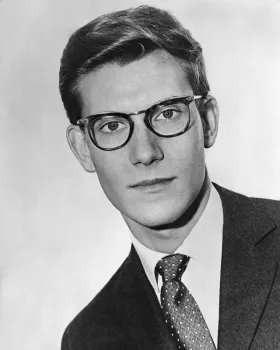
Yves Saint Laurent (often abbreviated as YSL) was a name that reshaped the world of fashion. Known for his revolutionary designs, artistic collaborations, and breaking traditional gender norms in clothing, he is one of the most influential designers of the 20th century. His work wasn’t just about creating clothes; it was about making a statement—empowering women, introducing modern aesthetics, and setting trends that still influence fashion today.
From working with Christian Dior to building his own empire, Yves Saint Laurent’s career was a story of passion, creativity, and resilience. His bold innovations, such as the women’s tuxedo suit, safari jackets, and Mondrian dresses, redefined how fashion blended with art and culture. In this article, we’ll dive deep into his life, career, struggles, and legacy.
Table of Contents
Early Life and Background
Yves Henri Donat Mathieu-Saint-Laurent was born on August 1, 1936, in Oran, Algeria, which was then a French colony. Growing up in a privileged yet conservative environment, he found himself drawn to art and fashion from a young age. His early sketches were heavily inspired by his love for theatre, costume design, and haute couture.

photo/museeyslparis
As a teenager, Laurent moved to Paris, where he pursued his dream of becoming a fashion designer. He studied at the prestigious École de la Chambre Syndicale de la Couture Parisienne, where his talents quickly caught the attention of industry professionals. His work was sophisticated and elegant, even at an early age.
One of the most pivotal moments in his young career came when he won a design contest at the age of 17. His designs impressed Michel de Brunhoff, the editor of Vogue Paris, who introduced him to Christian Dior. This meeting changed his life forever, as Dior saw the immense potential in the young designer.
Rise to Fame: Joining Dior
In 1955, at just 19 years old, Yves Saint Laurent began working as Christian Dior’s assistant. The relationship between the two was built on mutual admiration. Dior mentored him closely, recognizing his exceptional talent.
However, in 1957, Christian Dior unexpectedly passed away, leaving the legendary fashion house in need of a new creative director. At only 21 years old, Yves Saint Laurent was given the immense responsibility of leading Dior. His first collection, introduced in 1958, was a massive success, featuring the “Trapeze” silhouette, which became an instant hit in the fashion world.
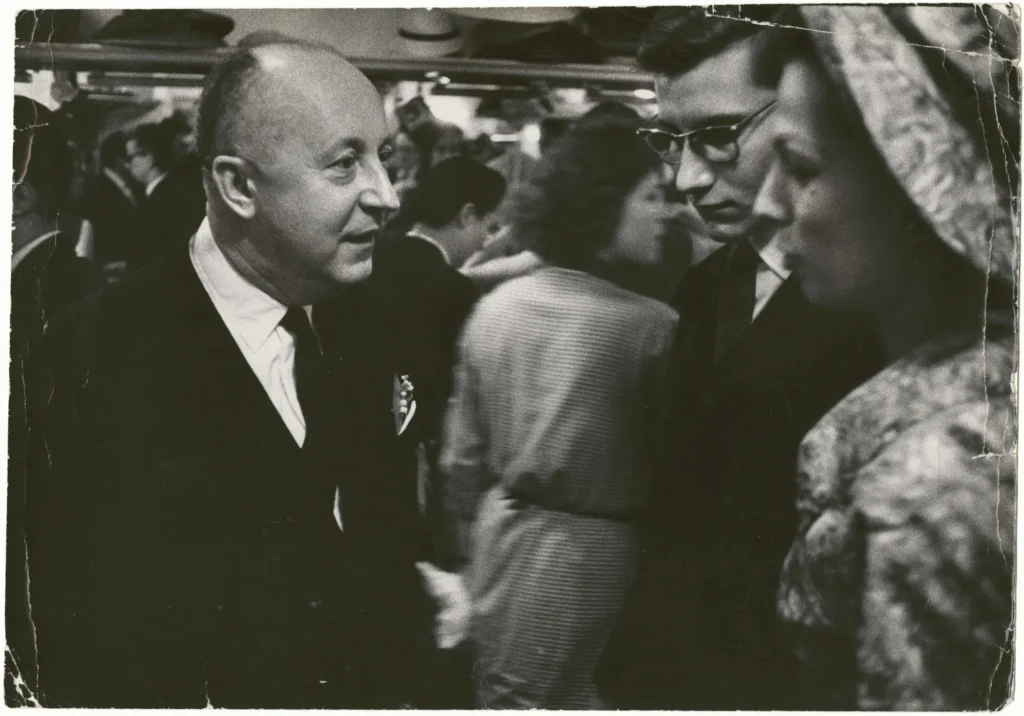
photo/museeyslparis
Under his leadership, Dior continued to thrive, but in 1960, he was drafted into military service during the Algerian War. His absence from the company led to his dismissal from Dior—a moment that devastated him but also pushed him towards creating his own brand.
YSL’s Design Philosophy
Even after his passing, Yves Saint Laurent’s design philosophy continues to influence the fashion industry. Modern designers, including Hedi Slimane, Tom Ford, and Anthony Vaccarello, have incorporated his ideas into their work.
His key contributions that still shape fashion today:
- Androgynous and gender-fluid clothing.

photo/dormeuil
- Luxury ready-to-wear collections by high-end brands.
- Art-inspired fashion pieces on the runway.
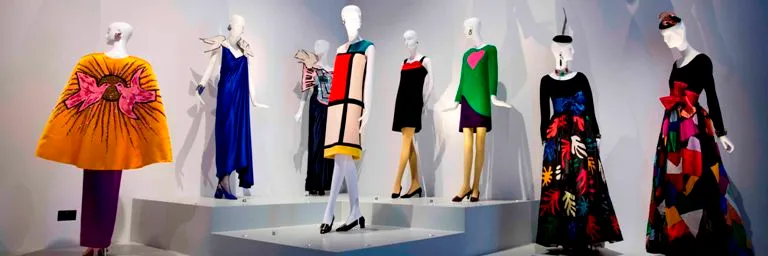
photo/exhibitingfashion
Yves Saint Laurent wasn’t just a designer—he was a revolutionary thinker who believed that fashion should be a mix of freedom, power, and beauty. His legacy continues to inspire generations of designers and fashion lovers around the world.
Notable Collections and Designs
Yves Saint Laurent was a visionary designer known for creating some of the most iconic collections in fashion history. His ability to blend art, culture, and bold innovation led to timeless designs that continue to influence contemporary fashion. Some of his most notable collections include:
The Mondrian Collection (1965)
One of the most famous creations by Yves Saint Laurent was the Mondrian dress, a simple A-line shift dress featuring bold blocks of red, yellow, blue, white, and black, inspired by the abstract paintings of Dutch artist Piet Mondrian. This collection was a revolutionary moment in fashion, proving that clothing could be a direct form of art.

photo/medium
The Pop Art Collection (1966)
He continued exploring the relationship between fashion and art with his Pop Art Collection, inspired by the works of Andy Warhol and other contemporary artists. This collection featured bright colors, sequined designs, and bold patterns that embraced the pop culture movement of the 1960s.
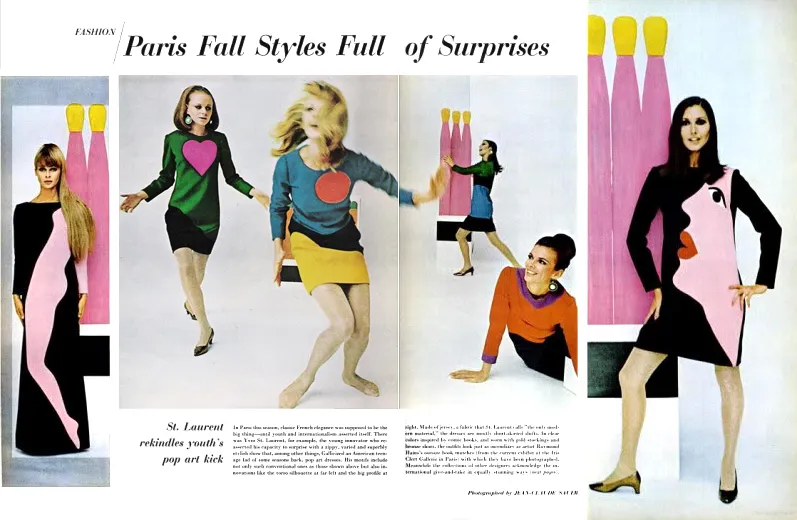
photo/makeminevogue
Le Smoking Tuxedo Suit (1966)
Yves Saint Laurent broke gender norms with his introduction of Le Smoking, the first tuxedo suit designed specifically for women. This groundbreaking design was met with controversy but quickly became an essential piece of women’s fashion, symbolizing power, sophistication, and rebellion against traditional dress codes.

photo/teyxo
The Safari Collection (1968)
Inspired by African and Middle Eastern cultures, Saint Laurent introduced the safari jacket, which was originally designed for men but became a staple in women’s fashion. The collection featured structured yet elegant safari jackets, jumpsuits, and khaki ensembles, showcasing his ability to merge utility with high fashion.
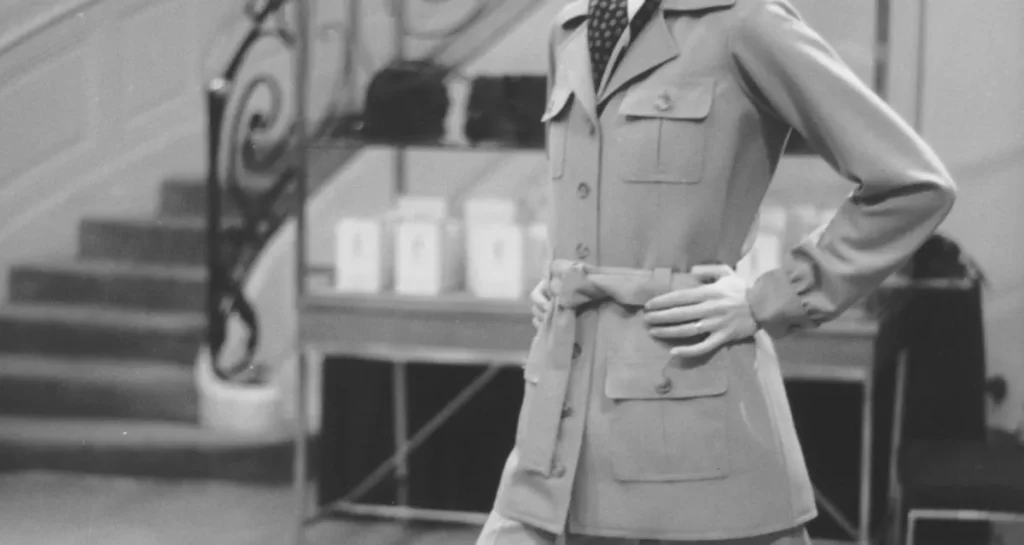
photo/The Safari Collection (1968)
The Ballet Russes Collection (1976)
In one of his most extravagant and theatrical collections, Yves Saint Laurent took inspiration from the Ballets Russes, the famous Russian ballet company. The collection featured luxurious fabrics, rich colors, and intricate embroidery, highlighting his love for culture and drama in fashion.

photo/pinterest
The Chinese and Moroccan Influence (1977-1981)
Saint Laurent frequently drew inspiration from different cultures, and his collections reflected his fascination with the Orient, Morocco, and other international influences. His designs featured kaftans, tunics, and rich brocades, capturing the essence of traditional attire while maintaining a modern, high-fashion appeal.

photo/bbc
His designs were not just about style but also about storytelling. He brought history, art, and culture into his clothing, making each collection a masterpiece of its own.
Also Read – Azzedine Alaïa: The Master of Timeless Fashion
Interesting Facts About Yves Saint Laurent
- He was the first living designer honored at the Met Museum
- He had a deep love for Morocco, which influenced his collections
- The YSL logo, created by Cassandre, remains iconic
Revolutionizing Women’s Fashion
Perhaps the most groundbreaking contribution of Yves Saint Laurent to fashion was his redefinition of women’s fashion. Before him, formal attire for women often consisted of dresses and skirts. But with the introduction of the Le Smoking tuxedo suit, he gave women an alternative—one that was bold, sleek, and empowering.
At the time, women wearing suits was still controversial, with some restaurants even banning women who arrived wearing his tuxedo suits. But his idea was clear: women should have the freedom to wear what makes them feel confident, just like men.
Other notable contributions included:
- The Mondrian dress (1965) – A geometric, color-blocked shift dress inspired by the paintings of Piet Mondrian.
- The Safari Jacket (1968) – A blend of adventure and elegance, making functional wear stylish.
- The Jumpsuit – Once seen only in workwear, he transformed it into a high-fashion statement.

photo/museeyslparis
His approach wasn’t just about aesthetics; it was about making a cultural statement. His work aligned with the feminist movement, giving women more agency over their wardrobe choices.
The Influence of Art and Culture
One of the most unique aspects of Yves Saint Laurent’s work was his deep connection to art, music, and culture. Unlike many designers who focused solely on fashion trends, Saint Laurent found inspiration in painting, theater, ballet, and literature.
Collaborations with Artists
Yves Saint Laurent collaborated with several artists throughout his career. His Mondrian Collection (1965) was a direct homage to the Dutch painter Piet Mondrian, and his Pop Art Collection (1966) reflected the influence of Andy Warhol’s bold, colorful works.
Inspiration from Different Cultures
Saint Laurent traveled extensively, drawing inspiration from Moroccan, Russian, Asian, and African cultures. His collections often featured traditional garments from these regions, such as Moroccan kaftans, Russian shawls, and African-inspired prints, blending them seamlessly into the world of haute couture.

photo/bbc
Theater and Ballet as Inspiration
His love for the performing arts played a crucial role in his designs. His Ballet Russes Collection (1976) was inspired by the extravagant costumes of the Russian ballet, while many of his evening gowns were reminiscent of stage costumes and opera attire.
Saint Laurent didn’t just create fashion—he created art. His work blurred the lines between clothing and fine art, making each piece a statement of beauty, history, and culture.
The Role of Muses and Models in His Career
Yves Saint Laurent’s career was deeply influenced by the women who wore his designs. He surrounded himself with strong, independent women, many of whom served as his muses and inspired his collections.
Catherine Deneuve – The Timeless Muse
French actress Catherine Deneuve was one of his most famous muses. He designed her wardrobe for several films, including Belle de Jour (1967), where she wore a series of elegant, sophisticated outfits that became iconic. Deneuve remained a lifelong friend and inspiration for Saint Laurent.

Yves Saint Laurent & Catherine Deneuve photo/museeyslparis
Betty Catroux – The Androgynous Icon
Betty Catroux, a model and socialite, represented the androgynous, rock-and-roll aesthetic that Yves Saint Laurent loved. She became the embodiment of his sleek, modern designs and was one of his closest confidantes.
Loulou de la Falaise – The Bohemian Spirit
Loulou de la Falaise was not only a muse but also a key collaborator. She contributed to the accessories and jewelry designs of YSL and brought a bohemian, artistic energy to his collections.
Naomi Campbell, Claudia Schiffer, and the Supermodels
During the 1980s and 1990s, Saint Laurent’s runway shows featured supermodels like Naomi Campbell, Claudia Schiffer, and Cindy Crawford, cementing his role as a leader in modern haute couture.
His muses weren’t just models; they were icons who embodied the spirit of his designs. Their personalities, lifestyles, and aesthetics played a crucial role in shaping the YSL brand.
Perfume and Beauty Line Expansion
Aside from fashion, Yves Saint Laurent made a significant impact in the perfume and beauty industry. His fragrances became just as iconic as his clothing designs.
YSL’s Most Famous Fragrances:
- Opium (1977) – A bold, spicy perfume that became controversial yet wildly successful.

photo/29secrets
- Rive Gauche (1971) – A fresh, floral scent that represented the independent, modern woman.

photo/fragrantica
- Paris (1983) – A romantic fragrance dedicated to the beauty of Parisian women.
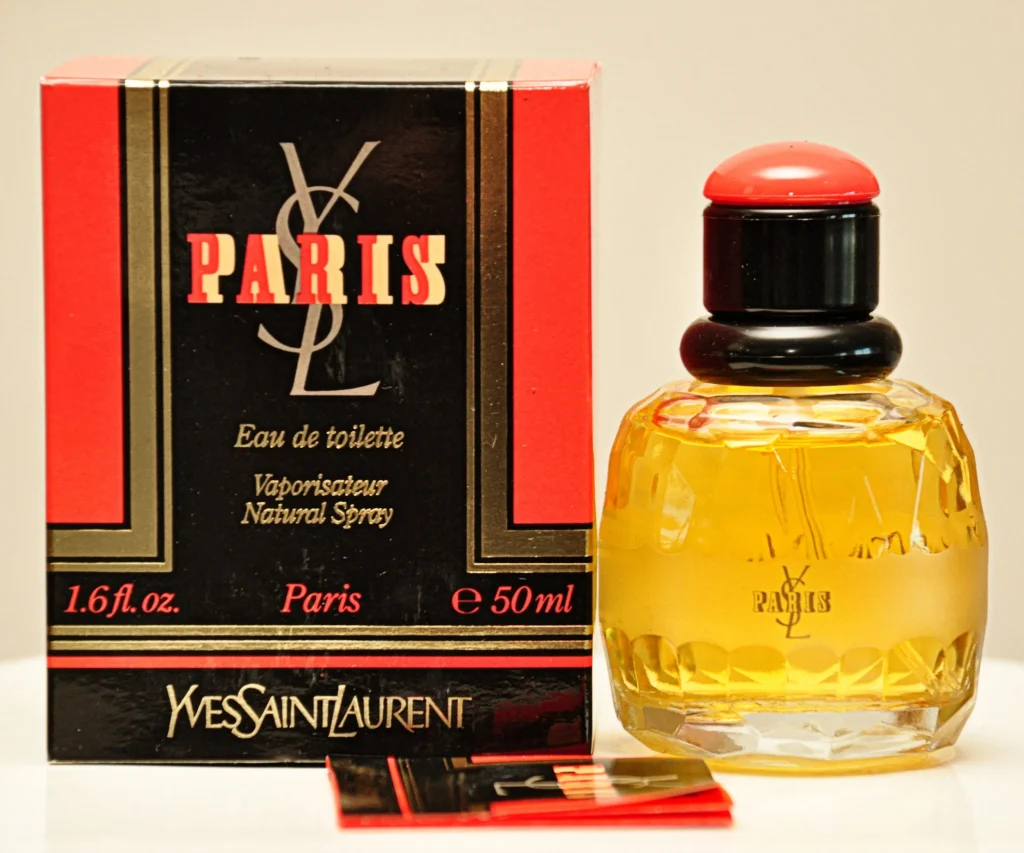
photo/etsy
- Black Opium (2014, posthumous release) – A modern twist on the classic Opium, appealing to a younger audience.

photo/fragrantica
Beyond fragrances, YSL’s beauty line expanded to makeup, skincare, and cosmetics, establishing itself as a luxury brand in the beauty industry.
Struggles and Personal Life
Despite his immense success, Yves Saint Laurent faced several personal struggles.
Battles with Mental Health and Addiction
The pressure of the fashion industry took a toll on him. He struggled with depression, anxiety, and substance abuse, which affected his career at various points.
Relationship with Pierre Bergé
Saint Laurent’s longtime partner, Pierre Bergé, played a crucial role in his life and career. They were both business and life partners, building the YSL empire together. Despite their personal struggles, Bergé remained by his side until the end.

Yves Saint & Pierre Bergé/photo/thenytimes
Overcoming Challenges
Despite his battles, Yves Saint Laurent continued to innovate and push boundaries. His work ethic and passion for fashion never wavered, and his legacy remains untouched.
YSL’s Contribution to Haute Couture and Ready-to-Wear
Yves Saint Laurent transformed the fashion industry in two key ways: by elevating haute couture to an artistic level and pioneering ready-to-wear (prêt-à-porter) fashion for the masses. His ability to merge high fashion with accessibility made him one of the most influential designers of all time.
Haute Couture: The Art of Luxury
Haute couture, or high fashion, is known for its intricate craftsmanship and exclusivity. Saint Laurent mastered this art, creating gowns that were more than just clothing—they were masterpieces. Some of his most famous haute couture designs include:
- Embroidered evening gowns inspired by art (e.g., the Mondrian dress and Van Gogh jacket)
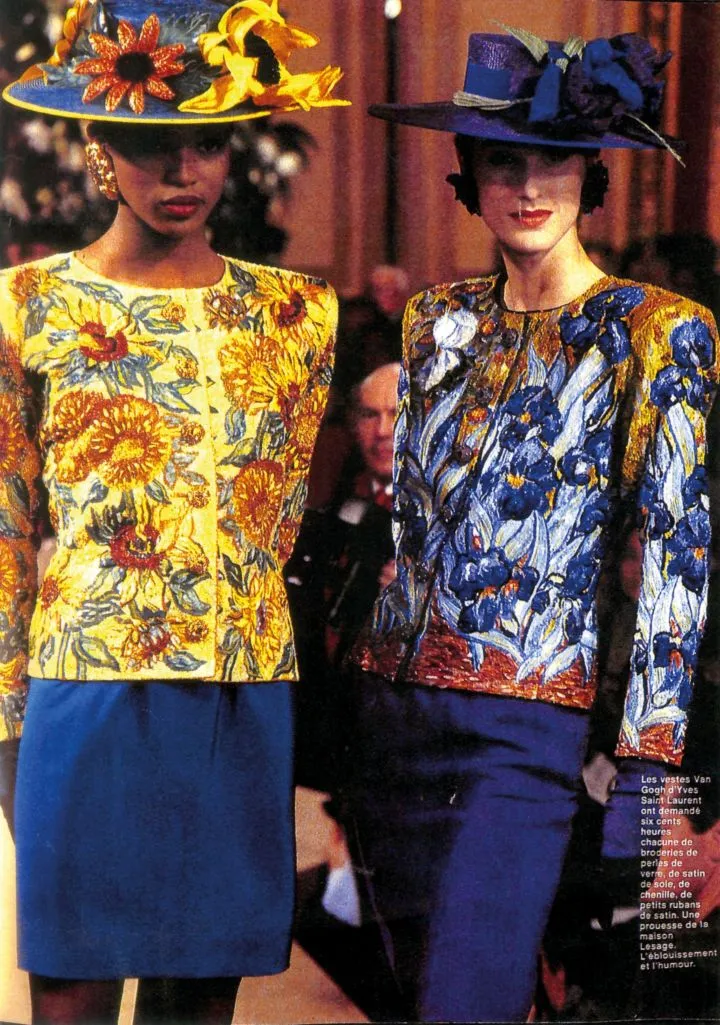
Yves Saint Laurent Van Gogh jacket/photo/prestigeonline
- Intricate beaded and sequin dresses seen on royalty and celebrities
- Dramatic opera coats and flowing capes inspired by history and theater
His haute couture collections were dramatic, elegant, and timeless, drawing inspiration from various cultures and artistic movements.
The Birth of Ready-to-Wear Fashion
Before Yves Saint Laurent, luxury fashion was reserved for the elite. In 1966, he revolutionized the industry by launching Rive Gauche, the first-ever ready-to-wear line by a haute couture designer. This move made high fashion more accessible to everyday women.
Why was this significant?
- It allowed women to buy designer clothes without the couture price tag.
- It brought high fashion into department stores.
- It changed the way designers approached clothing production.
The Business of Fashion: YSL as a Global Brand
What started as a designer’s dream turned into one of the most recognizable luxury brands in the world. Yves Saint Laurent’s brand expanded beyond clothing into perfume, accessories, and cosmetics, creating a powerful fashion empire.

Yves Saint Laurent Toronto Store/photo/retail insider
Marketing and Branding Strategy
YSL was one of the first designers to embrace bold advertising and branding.
- Controversial Perfume Ads – The launch of Opium (1977) was one of the most talked-about campaigns in history.
- Supermodel Campaigns – Featuring icons like Naomi Campbell and Claudia Schiffer.
- Celebrity Influence – Dressing stars like Catherine Deneuve, Bianca Jagger, and Princess Diana.
Luxury and Mass Appeal Balance
YSL mastered the balance between exclusivity and accessibility, creating:
- Haute couture for elite clients
- Ready-to-wear collections for everyday consumers
- Fragrances, handbags, and beauty products for a global audience
Today, YSL is a powerhouse in the luxury industry, competing with brands like Chanel, Dior, and Gucci.
Retirement and Later Years
After decades of dominating the fashion world, Yves Saint Laurent retired in 2002. His final show was an emotional tribute to his career, featuring some of his most famous designs over the years.
Reasons for Retirement
- Health issues and mental exhaustion
- Changes in the fashion industry
- Desire to step away from the spotlight
After retiring, he lived a quiet life with his partner, Pierre Bergé, in Marrakech, Morocco, where he focused on art and personal passions.
Death and Posthumous Recognition
On June 1, 2008, Yves Saint Laurent passed away at the age of 71 after battling brain cancer. His death marked the end of an era, but his legacy continued.
Honors and Memorials
- The Yves Saint Laurent Museum in Paris and Marrakech was established in his honor.

The Yves Saint Laurent Museum in Paris/photo/thenytimes
- His brand continued to grow under new creative leadership, including designers like Hedi Slimane and Anthony Vaccarello.
- Celebrities and designers paid tribute, recognizing his lasting impact on fashion.
Enduring Influence on Fashion
Today, YSL remains a symbol of:
- Timeless elegance
- Empowerment through fashion
- The blending of art and style
His revolutionary designs continue to inspire modern designers, proving that true fashion never fades.
Yves Saint Laurent at a Glance:
| Category | Details |
|---|---|
| Full Name | Yves Henri Donat Mathieu-Saint-Laurent |
| Birth Date & Place | August 1, 1936, in Oran, Algeria |
| Death | June 1, 2008, in Paris, France |
| Education | École de la Chambre Syndicale de la Couture Parisienne |
| Early Career | Assistant to Christian Dior (1955) |
| Rise to Fame | Became Creative Director of Dior at 21 after Dior’s death (1957) |
| Own Fashion House | Founded Yves Saint Laurent (YSL) in 1961 |
| Design Philosophy | Empowerment through fashion, blending art with style, revolutionizing women’s fashion |
| Notable Innovations | Women’s tuxedo suit (Le Smoking), Safari jacket, Mondrian dress, Jumpsuits, See-through blouses |
| Famous Collections | Mondrian Collection (1965), Pop Art Collection (1966), Ballet Russes Collection (1976), Safari Collection (1968) |
| Influence on Women’s Fashion | Introduced androgynous clothing, ready-to-wear luxury fashion, broke gender norms in dressing |
| Cultural Inspirations | Moroccan kaftans, Russian shawls, Asian embroideries, Ballet costumes |
| Famous Muses | Catherine Deneuve, Betty Catroux, Loulou de la Falaise, Naomi Campbell, Claudia Schiffer |
| Perfume Line | Opium (1977), Rive Gauche (1971), Paris (1983), Black Opium (2014) |
| Ready-to-Wear Line | Launched Rive Gauche in 1966, making luxury fashion accessible |
| Business Expansion | YSL became a global luxury brand, expanding into perfumes, cosmetics, and accessories |
| Retirement | Retired in 2002 after decades of influence |
| Posthumous Recognition | Musée Yves Saint Laurent in Paris and Marrakech, tributes by top designers |
| Enduring Influence | Continues to inspire modern designers, influencing gender-fluid fashion, art-inspired collections, and luxury branding |
Conclusion
Yves Saint Laurent wasn’t just a designer—he was an artist, a visionary, and a revolutionary force in fashion. He redefined women’s fashion, gave us the power suit, introduced ready-to-wear luxury, and made art wearable.
His influence is alive today, seen in modern power dressing, high fashion collaborations, and the iconic YSL brand. From Le Smoking tuxedo to the Mondrian dress, his designs remain timeless, proving that true style never goes out of fashion.
Yves Saint Laurent will always be remembered as a legend who changed the way we dress.
FAQs
1. What made Yves Saint Laurent unique in fashion?
Yves Saint Laurent was unique because he blended art, culture, and fashion while breaking traditional gender norms. His introduction of the women’s tuxedo suit, safari jackets, and bohemian chic changed the fashion industry forever.
2. What is Yves Saint Laurent’s most famous design?
His most famous designs include Le Smoking tuxedo suit (1966), the Mondrian dress (1965), the Safari jacket (1968), and the sheer blouse (1966). These pieces remain iconic and influential today.
3. How did YSL influence women’s fashion?
Yves Saint Laurent gave women more freedom and power in fashion by introducing tailored suits, ready-to-wear clothing, and bold statement pieces. His designs empowered women to dress for themselves rather than societal expectations.
4. What is the legacy of Yves Saint Laurent today?
YSL’s legacy lives on through the Yves Saint Laurent brand, which continues to produce luxury fashion, perfumes, and accessories. His designs influence modern fashion designers, stylists, and celebrities who embrace his timeless aesthetic.
5. Where can I see Yves Saint Laurent’s work today?
His work is showcased in museums like the Musée Yves Saint Laurent in Paris and Marrakech. The YSL brand also continues to release collections inspired by his original designs.
One thought on “Yves Saint Laurent – The Legendary Fashion Icon”